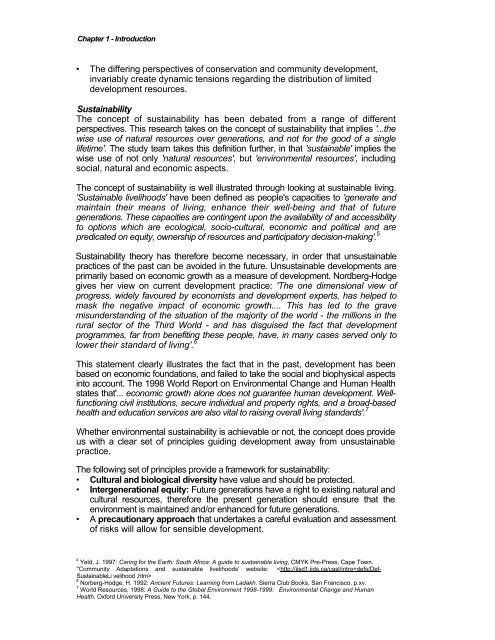Feasibility Study of Proposed Tourism Dev in Shewula, NE ...
Feasibility Study of Proposed Tourism Dev in Shewula, NE ...
Feasibility Study of Proposed Tourism Dev in Shewula, NE ...
You also want an ePaper? Increase the reach of your titles
YUMPU automatically turns print PDFs into web optimized ePapers that Google loves.
Chapter 1 - Introduction<br />
• The differ<strong>in</strong>g perspectives <strong>of</strong> conservation and community development,<br />
<strong>in</strong>variably create dynamic tensions regard<strong>in</strong>g the distribution <strong>of</strong> limited<br />
development resources.<br />
Susta<strong>in</strong>ability<br />
The concept <strong>of</strong> susta<strong>in</strong>ability has been debated from a range <strong>of</strong> different<br />
perspectives. This research takes on the concept <strong>of</strong> susta<strong>in</strong>ability that implies '...the<br />
wise use <strong>of</strong> natural resources over generations, and not for the good <strong>of</strong> a s<strong>in</strong>gle<br />
lifetime'. The study team takes this def<strong>in</strong>ition further, <strong>in</strong> that 'susta<strong>in</strong>able' implies the<br />
wise use <strong>of</strong> not only 'natural resources', but 'environmental resources', <strong>in</strong>clud<strong>in</strong>g<br />
social, natural and economic aspects.<br />
The concept <strong>of</strong> susta<strong>in</strong>ability is well illustrated through look<strong>in</strong>g at susta<strong>in</strong>able liv<strong>in</strong>g.<br />
'Susta<strong>in</strong>able livelihoods' have been def<strong>in</strong>ed as people's capacities to 'generate and<br />
ma<strong>in</strong>ta<strong>in</strong> their means <strong>of</strong> liv<strong>in</strong>g, enhance their well-be<strong>in</strong>g and that <strong>of</strong> future<br />
generations. These capacities are cont<strong>in</strong>gent upon the availability <strong>of</strong> and accessibility<br />
to options which are ecological, socio-cultural, economic and political and are<br />
predicated on equity, ownership <strong>of</strong> resources and participatory decision-mak<strong>in</strong>g'. 5<br />
Susta<strong>in</strong>ability theory has therefore become necessary, <strong>in</strong> order that unsusta<strong>in</strong>able<br />
practices <strong>of</strong> the past can be avoided <strong>in</strong> the future. Unsusta<strong>in</strong>able developments are<br />
primarily based on economic growth as a measure <strong>of</strong> development. Nordberg-Hodge<br />
gives her view on current development practice: 'The one dimensional view <strong>of</strong><br />
progress, widely favoured by economists and development experts, has helped to<br />
mask the negative impact <strong>of</strong> economic growth.... This has led to the grave<br />
misunderstand<strong>in</strong>g <strong>of</strong> the situation <strong>of</strong> the majority <strong>of</strong> the world - the millions <strong>in</strong> the<br />
rural sector <strong>of</strong> the Third World - and has disguised the fact that development<br />
programmes, far from benefit<strong>in</strong>g these people, have, <strong>in</strong> many cases served only to<br />
lower their standard <strong>of</strong> liv<strong>in</strong>g'. 6<br />
This statement clearly illustrates the fact that <strong>in</strong> the past, development has been<br />
based on economic foundations, and failed to take the social and biophysical aspects<br />
<strong>in</strong>to account. The 1998 World Report on Environmental Change and Human Health<br />
states that'... economic growth alone does not guarantee human development. Wellfunction<strong>in</strong>g<br />
civil <strong>in</strong>stitutions, secure <strong>in</strong>dividual and property rights, and a broad-based<br />
health and education services are also vital to rais<strong>in</strong>g overall liv<strong>in</strong>g standards'. 7<br />
Whether environmental susta<strong>in</strong>ability is achievable or not, the concept does provide<br />
us with a clear set <strong>of</strong> pr<strong>in</strong>ciples guid<strong>in</strong>g development away from unsusta<strong>in</strong>able<br />
practice.<br />
The follow<strong>in</strong>g set <strong>of</strong> pr<strong>in</strong>ciples provide a framework for susta<strong>in</strong>ability:<br />
• Cultural and biological diversity have value and should be protected.<br />
• Intergenerational equity: Future generations have a right to exist<strong>in</strong>g natural and<br />
cultural resources, therefore the present generation should ensure that the<br />
environment is ma<strong>in</strong>ta<strong>in</strong>ed and/or enhanced for future generations.<br />
• A precautionary approach that undertakes a careful evaluation and assessment<br />
<strong>of</strong> risks will allow for sensible development.<br />
4<br />
Yeld, J. 1997: Car<strong>in</strong>g for the Earth: South Africa: A guide to susta<strong>in</strong>able liv<strong>in</strong>g, CMYK Pre-Press, Cape Town.<br />
''Community Adaptations and susta<strong>in</strong>able livelihoods' website: <br />
8<br />
Norberg-Hodge, H. 1992: Ancient Futures: Learn<strong>in</strong>g from Ladakh. Sierra Club Books, San Francisco, p.xv.<br />
7<br />
World Resources, 1998: A Guide to the Global Environment 1998-1999: Environmental Change and Human<br />
Health. Oxford University Press, New York, p. 144.












